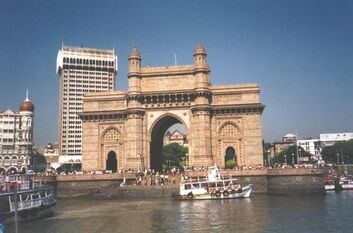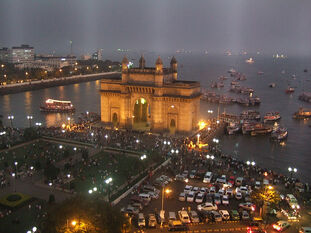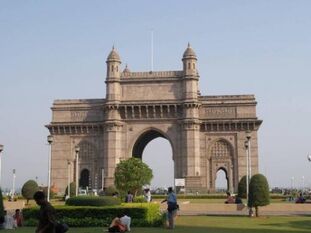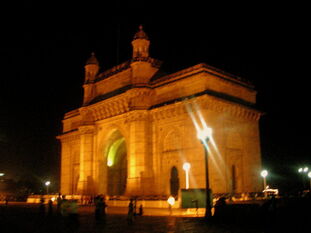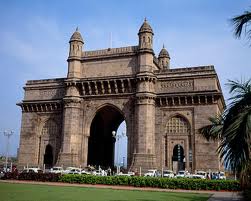No edit summary |
(Adding categories) |
||
| Line 31: | Line 31: | ||
Images (8).jpg |
Images (8).jpg |
||
</gallery></p> |
</gallery></p> |
||
| + | [[Category:Monument]] |
||
Revision as of 02:27, 24 March 2013
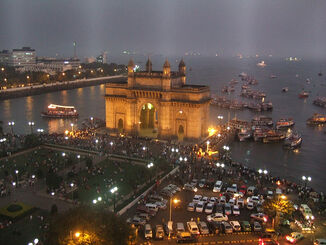
The Gateway of India is a monument built during the British Raj in Mumbai (formerly Bombay), India. Located on the waterfront in the Apollo Bunder area in South Mumbai, the monument overlooks the Arabian Sea. The gateway is a basalt arch, 26 metres (85 feet) high. It lies at the end of Chhatrapati Shivaji Marg at the water's edge in the harbor of Bombay. Previously, it was a crude jetty used by the fishing community which was later renovated and used as a landing place for British governors and other prominent people. In earlier times, the gateway was the monument that visitors arriving by boat would have first seen in Mumbai. The gateway has also been referred to as the Taj Mahal of Mumbai and is the city's top tourist attraction.
The monument was erected to commemorate the landing on the Apollo Bunder of their MajestiesKing George V and Queen Mary when they visited India in 1911. Built in Indo-Saracenic style, the foundation stone for the Gateway of India was laid on 31 March 1911. The final design of George Wittet was sanctioned in 1914 and the construction of the monument was completed in 1924. The gateway was latterly the ceremonial entrance to India for Viceroys and the newGovernors of Bombay. It served to allow entry and access to India.
The monument has been a target of three terror attacks from the beginning of the 21st century; twice in 2003 and it was also the disembarkation point in 2008 when four gunmen attacked the Taj Mahal Palace & Tower.
History
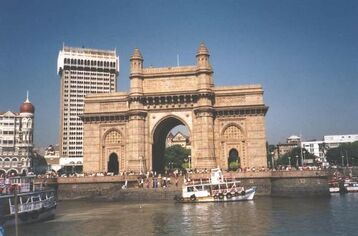
The Gateway of India was built to commemorate the visit of King George V and Queen Mary to Bombay, prior to the Delhi Durbar, in December 1911. However, they only got to see only a cardboard model of the structure since the construction did not begin till 1915. The foundation stone was laid on 31 March 1911, by the Governor of Bombay Sir George Sydenham Clarke, with the final design of George Wittet sanctioned on 31 March 1913. The gateway was built from yellow basalt and concrete.Between 1915 and 1919, work proceeded on reclamations at Apollo Bundar (Port) for the land on which the gateway and the new sea wall would be built. The foundations were completed in 1920, and construction was finished in 1924. The gateway was opened on 4 December 1924, by the Viceroy, the Earl of Reading.
The last British troops to leave India following India's independence, the first Battalion of theSomerset Light Infantry, passed through the gateway on their way out in a ceremony on 28 February 1948, signalling the end of its rule.
Significance
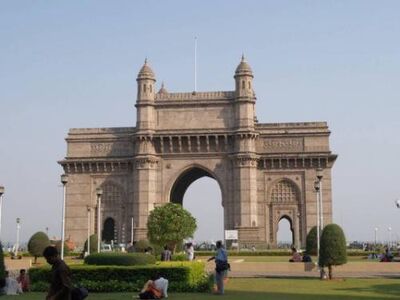
It is the place where the Viceroys and Governors used to land upon their arrival in India. The Gateway of India, though built as a welcome to King George V for his visit of 1911, then an event of grand significance for British India and the British empire, today serves as a "monumental memento" of colonialisation and subjugation by the British over the people of India. Built right next to the imposing and prestigious Taj Mahal Palace & Tower hotel, for Britishers arriving for the first time to India, the gateway was a symbol of the power and majesty of the British empire.
Opposite the gateway stands the statue of Chhatrapati Shivaji Maharaj, the king who used guerilla warfare to establish the Maratha empire in the Sahyadri mountain range in the 17th century, as a symbol of Maratha pride and courage. The statue was unveiled on 26 January 1961 on the occasion India's Republic Day. The other statue in the area is that of Swami Vivekananda.
The Gateway of India itself is a major tourist destination and a popular gathering spot for locals, giant-balloon sellers and photographers.
